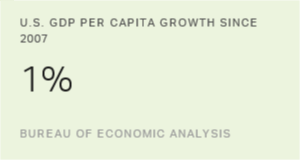PRINCETON, NJ -- Unemployment, as measured by Gallup without seasonal adjustment, was 8.3% for the 30 days ending Oct. 23 -- down sharply from 9.0% for the 30 days ending Sept. 4. Over the same period last year, Gallup's U.S. unemployment rate was steady or increasing, suggesting the lower unemployment Gallup has measured in recent weeks is not fully the result of seasonal hiring patterns. As a result, the government next week is likely to report a seasonally adjusted October unemployment rate of less than 9.0%.
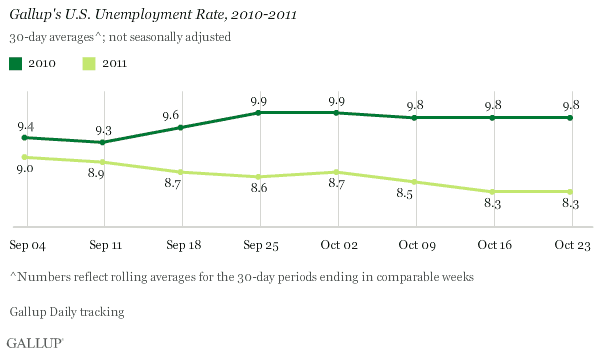
Gallup also finds a decline in the percentage of part-time workers who want full-time work, to 9.2% in the 30 days ending Oct. 23 from 9.6% for the period ending Sept. 4.
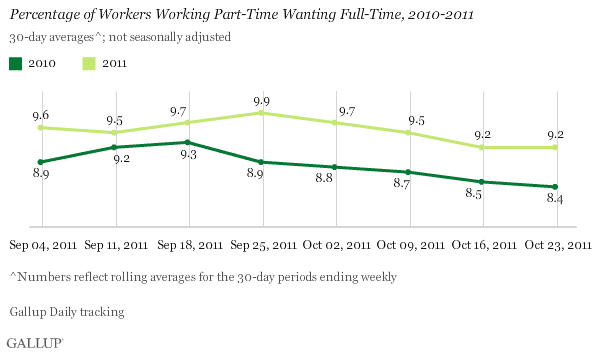
Underemployment, a measure that combines the percentage of workers who are unemployed with the percentage working part time but wanting full-time work, stands at 17.5% in the 30 days ending Oct. 23, down sharply from 18.6% for the 30 days ending Sept. 4 and the 18.2% of the comparable week a year ago. Underemployment based on 30-day rolling averages remains at its lowest measurement of the year over each of the past two weeks.
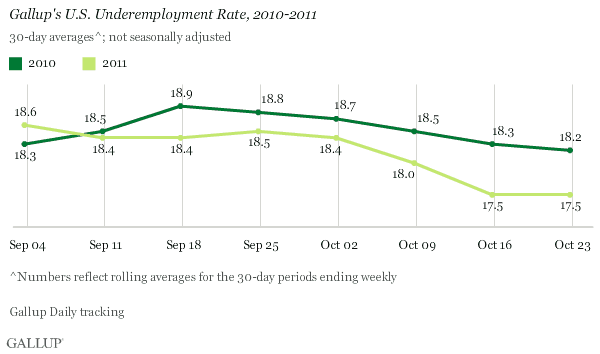
The Government's Next Unemployment Report
Gallup is documenting a clear decline in unemployment and underemployment during October. Modeling based on statistical comparisons of Gallup's unemployment data to the government's seasonally adjusted data over time suggests that the Bureau of Labor Statistics could report an October unemployment rate of less than 9.0% on the first Friday in November.
The improvement in Gallup's measures may partly reflect seasonal factors, because Gallup's data are not seasonally adjusted. However, Gallup did not see a similar decline in unemployment at this time last year, suggesting seasonal impacts are not the only factors in play.
Recently, some major retailers announced that they are adding thousands of new temporary employees for the holidays. This may help explain the October increase in hiring. It may also reflect how minimally these companies were staffed during the year.
On the other hand, the counterintuitive nature of this sharp improvement in the U.S. employment situation, as measured by Gallup during October, could also reflect earlier planning by companies for expected growth in the fourth quarter. If those expectations are not met, this October momentum could wane during the weeks ahead. Gallup's holiday sales expectations suggest sales similar to those of a year ago.
Regardless, this improvement in the U.S. employment situation appears real right now -- and, in turn, this suggests that those on Wall Street might find themselves rethinking their expectations about the economy and jobs as the year comes to a close.
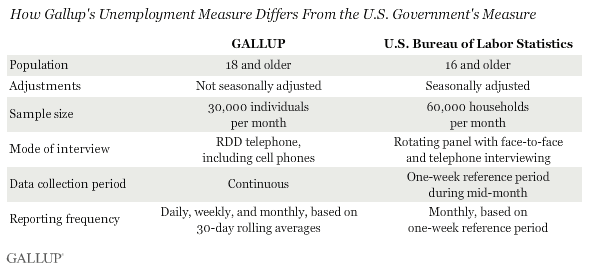
Gallup.com reports results from these indexes in daily, weekly, and monthly averages and in Gallup.com stories. Complete trend data are always available to view and export in the following charts:
Daily: Employment, Economic Confidence and Job Creation, Consumer Spending
Weekly: Employment, Economic Confidence, Job Creation, Consumer Spending
Read more about Gallup's economic measures.
View our economic release schedule.
Survey Methods
Gallup classifies American workers as underemployed if they are either unemployed or working part time but wanting full-time work. The findings reflect more than 18,000 phone interviews with U.S. adults aged 18 and older in the workforce, collected over a 30-day period. Gallup's results are not seasonally adjusted and are ahead of government reports by approximately two weeks.
Results are based on telephone interviews conducted as part of Gallup Daily tracking from Sept. 24-Oct. 23, 2011, with a random sample of approximately 18,000 adults, aged 18 and older, living in all 50 U.S. states and the District of Columbia, selected using random-digit-dial sampling.
For results based on the total sample of national adults, one can say with 95% confidence that the maximum margin of sampling error is ±1 percentage point.
Interviews are conducted with respondents on landline telephones and cellular phones, with interviews conducted in Spanish for respondents who are primarily Spanish-speaking. Each sample includes a minimum quota of 400 cell phone respondents and 600 landline respondents per 1,000 national adults, with additional minimum quotas among landline respondents by region. Landline telephone numbers are chosen at random among listed telephone numbers. Cell phone numbers are selected using random-digit-dial methods. Landline respondents are chosen at random within each household on the basis of which member had the most recent birthday.
Samples are weighted by gender, age, race, Hispanic ethnicity, education, region, adults in the household, and phone status (cell phone only/landline only/both, cell phone mostly, and having an unlisted landline number). Demographic weighting targets are based on the March 2010 Current Population Survey figures for the aged 18 and older non-institutionalized population living in U.S. telephone households. All reported margins of sampling error include the computed design effects for weighting and sample design.
In addition to sampling error, question wording and practical difficulties in conducting surveys can introduce error or bias into the findings of public opinion polls.
View methodology, full question results, and trend data.
For more details on Gallup's polling methodology, visit www.gallup.com.
